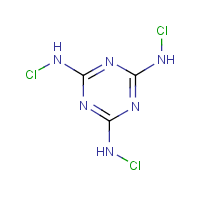Trichloromelamine
Agent Name
Trichloromelamine
CAS Number
7673-09-8
Formula
C3-H3-Cl3-N6
Major Category
Other Uses

Synonyms
1,3,5-Triazine, N,N',N''-trichloro-2,4,6-triamino-; 2,4,6-Tris(chloroamine)triazine; Chloromelamine; Decco salt NO 5; N,N',N''-Trichloro-2,4,6-triamine-1,3,5-triazine; TCM; Trichloromelamine (VAN); 1,3,5-Triazine-2,4,6-triamine, N,N',N''-trichloro-; 1,3,5-Triazine-2,4,6-triamine, N2,N4,N6-trichloro-; Melamine, N2,N4,N6-trichloro- (8CI); N2,N4,N6-Trichloro-2,4,6-triamino-s-triazine; [ChemIDplus]
Category
Biocides/Disinfectants
Description
White or off-white to yellow solid with an odor of chlorine; [CAMEO] Cream colored solid; [Reference #1]
Sources/Uses
Used as general purpose algicide, disinfectant, biocide, and sanitizer for food-contact and non-food contact (hospital, commercial, and industrial) applications targeting bacteria and algae; [Reference #1] Used in chlorine bleach and as bactericide and fungicide; [NTP]
Comments
A strong oxidizing agent; Harmful by ingestion and inhalation; A skin, eye, mucous membrane, and upper respiratory tract irritant; [CAMEO] Breaks down quickly forming hypochlorous acid and melamine; LOAEL = 150 mg/kg/day in a 90-day gavage study of rats; Corrosive to eyes in animal testing; “Chronic toxicity studies are not required for trichloromelamine based on its rapid degradation.” [Reference #1] See "Melamine."
Reference Link #1
Biomedical References
Exposure Assessment
Vapor Pressure
7.1E-05 mm Hg
Lethal Concentration
LC50 (rat) = 400 mg/m3
Adverse Effects
Hepatotoxin
Hepatoxic (a) from occupational exposure (secondary effect) or (b) in animal studies or in humans after ingestion
Diseases, Processes, and Activities Linked to This Agent
Processes
Industrial Processes with risk of exposure: